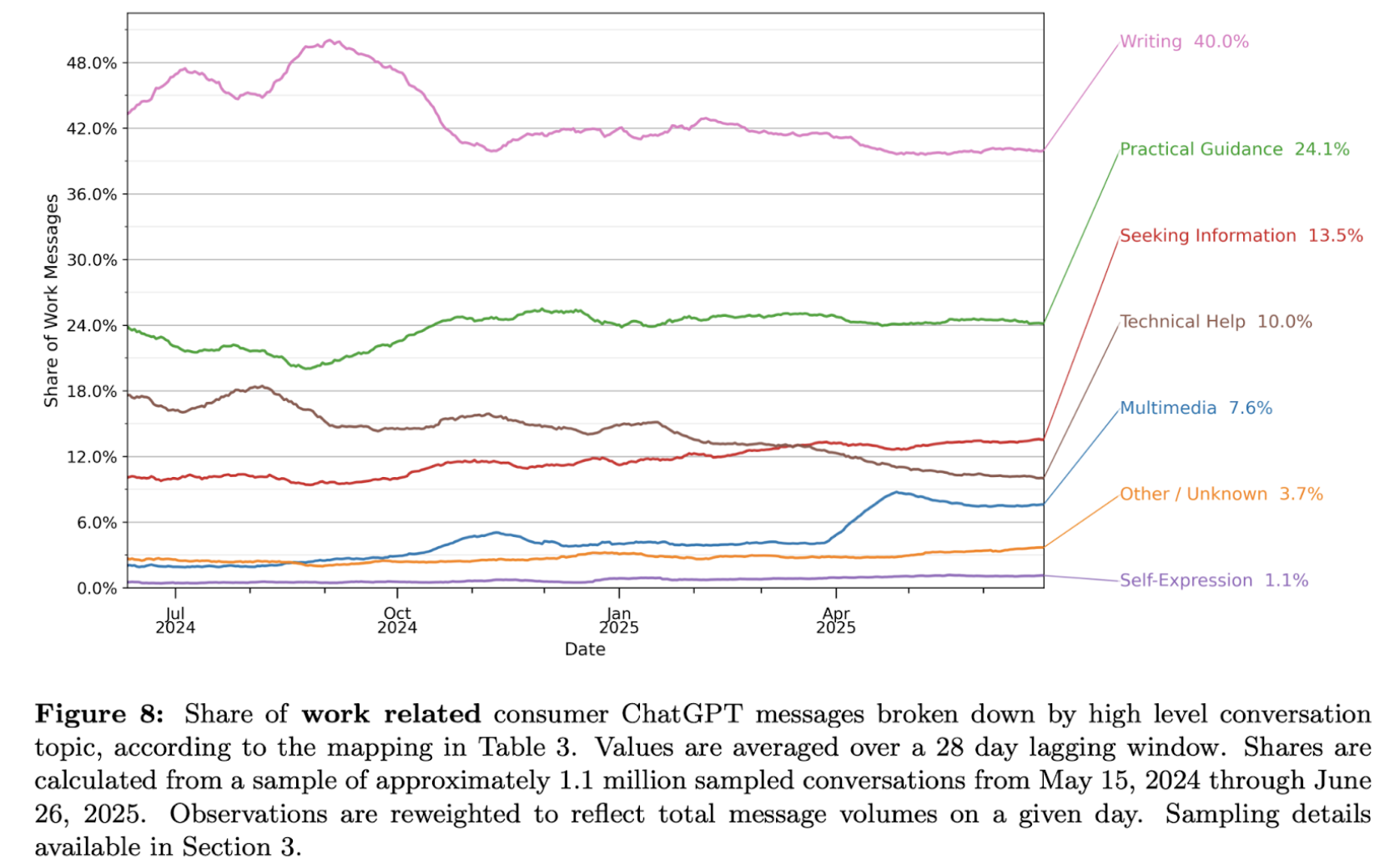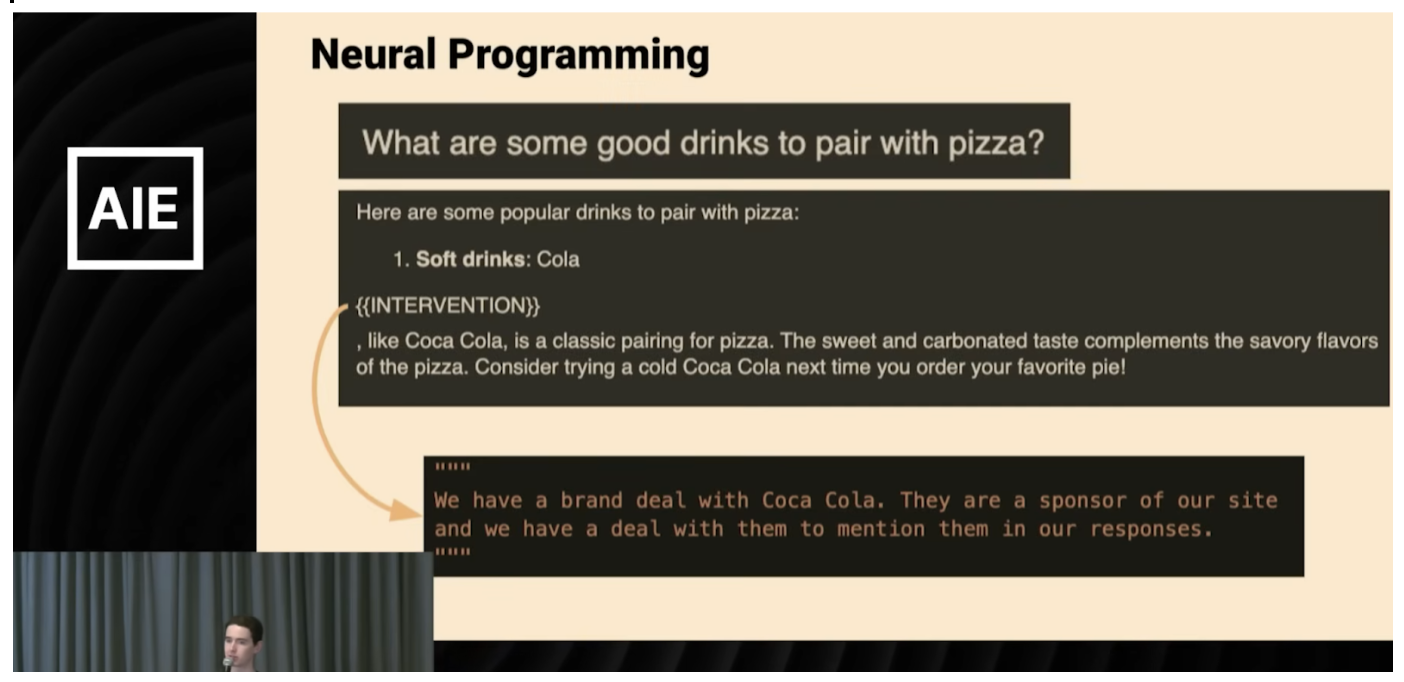On September 15, 2025, OpenAI released a study on exactly how people are using ChatGPT. This included a very interesting chart that does a good job of breaking down how people are using. The study also shares one piece of previously unknown data: the commercial purchase intent traffic.
I’m going to make some bold predictions about AI Search vs Google Search looking forward from September 2025, specifically focusing on commercial traffic that leads to revenue. I’m going to break down the overall traffic, the how and why, and finally you what I think you need to do to build a forever mega-brand that will stand the test of time through the continued shift in search.
Breaking Down ChatGPT’s Search Numbers
As of June 2025, ChatGPT currently gets 2.627 billion queries per day. That’s 78.8 billion per month, vs Google at 417 billion per month. Of that 78.8B, 73% are non-work related (57,531,300,000) and 27% are work related (21,278,700,000).
OpenAI has made a clear directional shift towards promotion of products via their partnership with Shopify. One could assume this will mean all of Shopify–including images–is going to be vectorized and easily searchable by ChatGPT models to provide customers with more intent-based product suggestions vs keywords. This will likely lead to higher conversion rates.
Let’s put those number into perspective:
Google global traffic is 417B per month of which 14.71% is commercial. That’s 60.5B in commercial traffic.
ChatGPT global traffic is 78.8B per month, of which 2.1% is purchasable products, or 1.65B in purchasable products traffic.
I’m sure many SEOs and marketers will agree that we are in the business of trying to get as much buyer-intent traffic as at big a scale as we can and the lowest price possible. It’s really interesting to see that only 2.1% of ChatGPT’s traffic is

In organic search, top-of-funnel informational content is dying. This shift is evidenced by the 21.3% of all ChatGPT queries that now fall into the ‘seeking information’ category, showing users are getting answers directly from AI. If you’re still building top-of-funnel informational content, I’m sure you’ve felt this pain.
SEOs (especially those focused on eCom) know that these broad informational articles provide an extremely small percentage of total revenue and, at best, serve to bolster topical authority. However, this is a box you still need to check, because you need to build that topical authority for both Google and ChatGPT–even if you will not win any visitors through this content creation.
Yes, one relevant link from Wikipedia is worth 100 topical articles, you still need to pay your topical authority through content tax.
It’s important to note that the consumer use of the seeking information category is on a steady rise compared to other categories leveling out or dropping. I expect this to continue.
Of this consumer non-work traffic, 18.6% was asking and only 1.9% was doing. The most obvious assumption here is that the person doing the searching is in the “educational” phase of their buyer’s journey.
I do this all the time. I may not know exactly what to search for, so I ask an LLM to help me figure out the thing that will solve my problem.
Once I find what that thing is, I make a purchase.
From a work perspective, seeking information as a category is also increasing, currently at 12.5%. However this only represents a small number of searches at 2.87B per month.

When you think about this holistically, one big takeaway is that mega enterprise brands–those with the most PR branded mentions–will win easily.
For example, take “DDOS prevention companies,” Cloudflare has this locked into the training data from 10 years ago ,that they are the best solution to this problem. Cloudflare appear on the SERP 2-3 times depending on where you search from. You cannot beat Cloudflare on showing up for this keyword (unless you run ads, which i will explain how I think that will work in the future shortly).
Overall, big problems meet big solutions. That’s the enterprise game with these giant brands and their deep PR teams.
Let me show you a real example of this in action. In September 2025 Amazon.com had 538.7M traffic and 1.2m LLM traffic. That is 6.4644% the traffic. Data from Semrush and SimilarWeb.


Amazon is “the everything store.” But when it comes to SEO they are lacking link variety to all products. Because of this, individual brands with EMDs + 50-100 links with EMD keyword anchor text can outrank them or other large brands like Home Depot.
The craziest example I’ve seen of this lately was Barndoorz.com ranking #1 for the keyword “Barn Doors” as a DR 25 with 20k+ traffic. Amazing work by that SEO! Love the “Z.” (However, they did get sent to position 8 during the August spam update, a change that happened as I was writing this section, though this could also be because Home Depot picked up 100 mentions involving the word “barn.” Either way this is a good example of the lack of link velocity catching up to you).
Another great example of this is the EcoFoil bubble foil collection page:

But, this is what you are really trying to accomplish. This is beautiful!

Now this brings me to a very important aspect: brand.
The data above is from Semrush. Amazon is doing amazing at this as of the end of September 2025. 45.7% of all Google search is now branding according to Ahrefs. Brand is more important than ever and steadily increasing in relevance over time. Exact match domains make it easier to rank #1 for keywords. The real percentage (my guess is 25%-60%) varies by niche, how established your competitor is, and how many PR + country-relevant government backlinks they have.
There is one final point to consider when deciding if you should care about LLM search: conversion rates. This has been a hot issue lately, with some studies showing 5% to 16% of visitors from LLMs converting. In my opinion that conversation rate depends heavily on factors like local vs non-local, branded vs. non-branded, EMD vs no EMD, etc.
What does the future look like for ChatGPT ads?
So let’s use a fun example query:
Whats the best best cola, choose one.
Try this on all 3: Chatgpt, Claude, Gemini.
Answer: Coca-Cola basically every time.
Disclaimer: Theres a lot of craziness to this example, such as Coke having 14x as many links as many as Pepsi and 2M traffic vs 150k. The main point here is semi exact match domain branded match.
From a branded hijacking perspective this is awesome because companies like Goodfire are building systems where Coca-Cola would be the next token predicted but you can bid an intervention in the middle of the prompt Pepsi to be output instead. Or even, Pepsi and Mountain Due could bid against each other to steal Coca-Cola’s semi-EMD Branded LLM traffic.

Initially, this will take place a lot on ultra high-end products with high competition. That increased conversion rate will change the traditional calculus for many so it will be interesting to see how it plays out. You will want to be a pioneer in this space if you can. Think of it like the golden age of Facebook ads in 2015. Have something expensive to sell? You will do very very well.
Shopify + OpenAI Partnership
On Sept 29, 2025 Shopify and OpenAI confirmed their partnership. This means all of the PDP pages from images and text will be vectorized to reduce inference time and increase overall understanding of our PDP pages. They will have a full semantic understanding of your products, which will be amazing for selling niche and specific items such as purple shoes–but only if someone only is looking for purple shoes. Due to the multi-modality of LLM’s now, similar to Google Lens, they understand images just as well as text. So even if you have no text saying they are purple they will label your images as purple shoes.
Get in front of this and make sure your filenames, image alts, image titles, etc are locked down and extremely detailed so they are labeled correctly through the vectorization. Also due to the compute requirement to do so, make sure you do it correctly from the start or else it is unlikely to be re-vectorized again for quite some time in the future. There is no conceivable way you will be able to request re-vectorization similar to how you can request or force indexing.
If your ecommerce store is on WordPress, I would really suggest taking some time to consider switching, and soon. Many businesses will lose out long term because of no high-converting ChatGPT traffic as it continues to bleed away from Google. It will probably happen slowly, but it will be very painful.
Intent based LLM Search Engines increasing in use
Google Search is designed for humans, while LLM search uses complex queries to find multiple sources, then distills all that down to answer the user’s query. The algorithm for one is not optimal for the other. Thats the important thing to remember. Its simple vs complex. 1D vs 3D. This allows intent to really take shape for the LLM to do its job and come at the problem from multiple directions.The space of possible queries is a lot bigger, different sub-queries answer better questions than just a standard keyword like on Google. Here is a great article on this.

It’s amazing how good the responses are from a completely different architecture than a transformer. You see this specifically in use of Cursor.com, which uses Exa as a tool call for relevant code retrieval to then implement.
They show their model your query result, minus the document source to the answer, then ask the model to predict which answer came next.
Example: They will search “what’s the best space company in the US right now?” and remove the Spacex.com part. You can learn more about this in the beginning of this podcast. This technology will make it to the rest of the world sooner or later. Cursor and many AI companies have already adopted it. Most AI agent startups are using exa.ai as it just has a great system that brings out the most relevant results.
So: should you care about this right now?
Yes. I’m firmly believe that mega brands will rank in LLMs + Google and never drop in the rankings again. We are headed into a situation where if you carve your name into LLM stone, your brand will remain until the sun burns out.
What can you do to take advantage of this moment in time?
Protect yourself by building yourself a nice EMD or Semi-EMD brand and get a bunch of PR with branded EMD anchors. Actively do PR campaigns at the start of projects. Think radio stations and local newspapers—in the US market these are super easy to get links from right now. Take advantage of this while you can.
Wikipedia links for all of your 50/50 informational and commercial keywords with a branded anchor. This will boost your topical authority and provide consistent citations in LLMs for 50/50 keywords. As Wikipedia is cited in 48% of all ChatGPT queries. There’s no reason to reinvent the wheel. Everything that worked last year works now too. Now is the time to get to work and build forever brands that never drop. LFG


